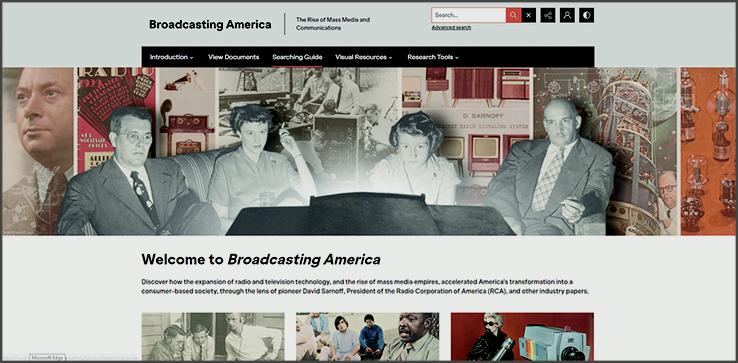Broadcasting America: The Rise of Mass Media and Communication | eReview
The documents and visual materials in this compilation detail the companies, events, and pioneers crucial to the 20th-century growth of the mass media and communications industry in the U.S.
Broadcasting America: The Rise of Mass Media and Communication
CONTENT This compilation of documents, essays, histories, biographies, and visuals explores the rise of American mass media and communications from the 1920s through the 1980s. Content is sourced from 13 collections in the Hagley Museum and Library and the University of Maryland’s Specials Collections and Archives, with a primary focus on the David Sarnoff Papers and Radio Corporation of America (RCA) materials. It includes 2,500 documents, 42 biographies, 21 company histories, six essays, and an extended glossary of technical and broadcasting terms. Particularly noteworthy are extensive time lines of the history of RCA and U.S. broadcasting as a whole and 876 galleries of advertisements, photographs, technical drawings, maps, and information graphics.
“Editor’s Choice” essays provide insight into various themes and subjects explored throughout the database. Featured articles cover topics as disparate as the space race, documentary films, and market research. Users will likely be engaged by the images available in the “Visual Resources” galleries. Images are grouped into three main categories: RCA photographs, advertising, and technical drawings. “Teaching Tools” feature a convenient and wide-ranging list of resources for educators and students.
USABILITY The home page boasts an impressive array of features, search options, and colorful photographs. A small general search box for basic and keyword searches is located discreetly in the upper right-hand corner of the screen with a link for advanced searching. An option for viewing the archive in high-contrast black-and-white mode is adjacent to the search box. Five drop-down options with links to information about the database are placed directly under the advanced-search link: introduction, view documents, searching guide, visual resources, and research tools. Six prominently located panels serve as gateways to the database’s content: nature and scope, essays, guide to the collection, galleries, “Trajectories of Postwar U.S. Television,” and a broadcasting-history time line. These drop-downs and panels are intuitive and provide streamlined access to the database.
Any term or subject can be entered in the basic search box. Searching by keyword, date, document type, theme, and collection is available in advanced search. Moreover, searches can be refined by date, document type, theme, collection, or library/archive. Results from the searches can be filtered by 23 document types (correspondence; advertisements; meeting minutes), 17 themes (censorship and ethics; art, music, and culture), and 13 collections. Each document has summary information with extensive source details and links to related document types, keywords, and themes. Viewing is enhanced by zoom, full-screen, and page-rotation options. Documents can be downloaded, emailed, and shared. Search results, response time, and the intuitive character of the database make for a pleasant user experience.
PRICING The database is available for perpetual access with pricing tailored for each institution. Contact Adam Matthew for custom price inquiries.
VERDICT The materials in this collection richly detail the companies, events, and pioneers crucial to the development and growth of the mass media and communications industry in the 20th-century United States. The database is not overwhelmingly large, but its subject-specificity is a strength, with relevant collections of noteworthy quality. Excellent content, well-constructed design, and user-friendly features make this a first-rate resource for anyone interested in the evolution of modern media.
RELATED
ALREADY A SUBSCRIBER? LOG IN
We are currently offering this content for free. Sign up now to activate your personal profile, where you can save articles for future viewing










Add Comment :-
Comment Policy:
Comment should not be empty !!!